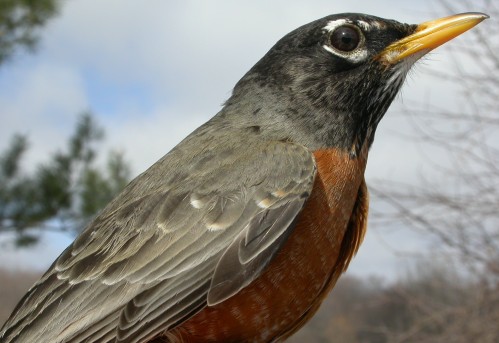|
McGILL BIRD OBSERVATORY |
|||||||||||||||||||||||||||||||||||||||||||||||
Welcome
to the McGill Bird Observatory weekly report.
Click here for a complete listing of our archives.
Banders-in-charge:
Marcel Gahbauer, Marie-Anne Hudson Notes: Though the weather was unseasonably cold for several days, we nonetheless saw a noticeable advance of migration in this second week of the spring season, with the cumulative list of species observed for the season jumping by 16 species. Among the new arrivals were Yellow-bellied Sapsucker, Northern Flicker, Belted Kingfisher, Tree Swallow, and Swamp Sparrow. The daily species totals have been creeping up, with a high of 37 on Sunday. The spring banding season began on on April 5, and will continue for 60 days. The first week of banding has been extremely quiet - relatively few migrants have returned yet, plus cold and/or wind severely restricted the operation of the nets most days. In fact, on our first day of the season, we had 2 cm of fresh snow on the ground, and spent the first half of the morning thawing out the nets! Though we would have wished for more bird activity, this result in itself is informative, and is something we can take into account when refining the spring program for next year. Although relatively few birds were caught, a number of them were notable. On Sunday, we banded a Pileated Woodpecker for only the second time in MBO's history. The two Golden-crowned Kinglets we banded on Friday doubled the meagre total from spring 2005 - they are a very early migrant, and one of the species that we have a better chance of documenting by starting as the earliest migrants begin to return. A female House Sparrow banded this week had one entirely white tail feather, and also a white primary covert - in each case, the third one from the outer edge on the right side! One thing we are looking forward to this spring is an increase in our number of "returns", i.e. banded birds that we have not captured in over three months. We expect that a number of the breeding individuals we banded last year will return, and that perhaps we will even recapture some of the young birds hatched at MBO last year. Already this week we have had several Song Sparrow returns, including a couple of individuals back for at least their third year, as we banded them in our first fall season, 2004. Other wildlife sighting over the past week have been varied. Deer have been around a few times, and at least one muskrat is being seen quite regularly. The spring peepers have amazed us by vocalizing even when the temperature is below freezing, though they have certainly been much more vocal on warmer days, and are being joined to some extent by wood frogs. Unfortunately we've also had our first mosquito sightings (or more accurately, bitings) of the year, and with water levels the way they are, this is probably something we'll have to get used to this year.
|



